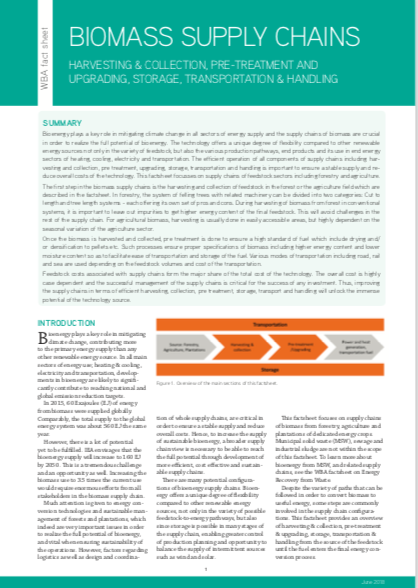Biomass Supply Chains
Back to Resources
Published:
2018-06
Summary
Bioenergy plays a key role in mitigating climate change in all sectors of energy supply and the supply chains of biomass are crucial in order to realize the full potential of bioenergy. The technology offers a unique degree of flexibility compared to other renewable energy sources not only in the variety of feedstock, but also the various production pathways, end products and its use in end energy sectors of heating, cooling, electricity and transportation. The efficient operation of all components of supply chains including har- vesting and collection, pre treatment, upgrading, storage, transportation and handling is important to ensure a stable supply and re- duce overall costs of the technology. This factsheet focusses on supply chains of feedstock sectors including forestry and agriculture.
The first step in the biomass supply chains is the harvesting and collection of feedstock in the forest or the agriculture field which are described in the factsheet. In forestry, the system of felling trees with related machinery can be divided into two categories: Cut to length and tree length systems – each offering its own set of pros and cons. During harvesting of biomass from forest in conventional systems, it is important to leave out impurities to get higher energy content of the final feedstock. This will avoid challenges in the rest of the supply chain. For agricultural biomass, harvesting is usually done in easily accessible areas, but highly dependent on the seasonal variation of the agriculture sector.
Once the biomass is harvested and collected, pre treatment is done to ensure a high standard of fuel which include drying and/ or densification to pellets etc. Such processes ensure proper specifications of biomass including higher energy content and lower moisture content so as to facilitate ease of transportation and storage of the fuel. Various modes of transportation including road, rail and sea are used depending on the feedstock volumes and cost of the transportation.
Feedstock costs associated with supply chains form the major share of the total cost of the technology. The overall cost is highly case dependent and the successful management of the supply chains is critical for the success of any investment. Thus, improving the supply chains in terms of efficient harvesting, collection, pre treatment, storage, transport and handling will unlock the immense potential of the technology source.

